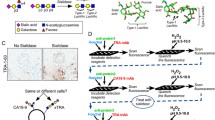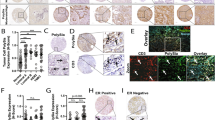Abstract
Histo-blood group antigens CD173 (H2) and CD174 (Lewis Y) are known to be developmentally regulated carbohydrate antigens which are expressed to a varying degree on many human carcinomas. We hypothesized that they might represent markers of cancer-initiating cells (or cancer stem cells, CSC). In order to test this hypothesis, we examined the co-expression of CD173 and CD174 with stem cell markers CD44 and CD133 by flow cytometry analysis, immunocytochemistry, and immunohistochemistry on cell lines and tissue sections from breast cancer. In three breast cancer cell lines, the percentage of CD173+/CD44+ cells ranged from 17% to >60% and of CD174+/CD44+ from 21% to 57%. In breast cancer tissue sections from 15 patients, up to 50% of tumor cells simultaneously expressed CD173, CD174, and CD44 antigens. Co-expression of CD173 and CD174 with CD133 was also observed, but to a lesser percentage. Co-immunoprecipitation and sandwich ELISA experiments on breast cancer cell lines suggested that CD173 and CD174 are carried on the CD44 molecule. The results show that in these tissues CD173 (H2) and CD174 (LeY) are associated with CD44 expression, suggesting that these carbohydrate antigens are markers of cancer-initiating cells or of early progenitors of breast carcinomas.



Similar content being viewed by others
References
Boman BM, Wicha MS (2008) Cancer stem cells: a step toward the cure. J Clin Oncol 26:2795–2799
Marhaba R, Zöller M (2004) CD44 in cancer progression: adhesion, migration and growth regulation. J Mol Histol 35:211–231
Takaishi S, Okumura T, Tu S et al (2009) Identification of gastric cancer stem cells using the cell surface marker CD44. Stem Cells 27:1006–1020
Tirino V, Desiderio V, d’Aquino R et al (2008) Detection and characterization of CD133+ cancer stem cells in human solid tumours. PloS One 3:e3469
Fujitani N, Liu Y, Toda S et al (2000) Expression of H type 1 antigen of ABO histo-blood group in normal colon and aberrant expressions of H type 2 and H type 3/4 antigens in colon cancer. Glycoconj J 17:331–338
Baldus SE, Mönig SP, Zirbes TK et al (2006) Lewis(y) antigen (CD174) and apoptosis in gastric and colorectal carcinomas: correlations with clinical and prognostic parameters. Histol Histopathol 21:503–510
Cao Y, Merling A, Karsten U et al (2001) The fucosylated histo-blood group antigens H type 2 (blood group O, CD173) and Lewis Y (CD174) are expressed on CD34+ hematopoietic progenitors but absent on mature lymphocytes. Glycobiology 11:677–683
Goupille C, Hallouin F, Meflah K et al (1997) Increase of rat colon carcinoma cells tumorigenicity by α(1-2) fucosyltransferase gene transfection. Glycobiology 7:221–229
Mani SA, Guo W, Liao MJ et al (2008) The epithelial–mesenchymal transition generates cells with properties of stem cells. Cell 133:704–715
Rapoport E, Pendu JL (1999) Glycosylation alterations of cells in late phase apoptosis from colon carcinomas. Glycobiology 9:1337–1345
Karsten U, Pilgrim G, Hanisch F-G et al (1988) A new monoclonal antibody (A46-B/B10) highly specific for the blood group H type 2 epitope: generation, epitope analysis, serological and histological evaluation. Br J Cancer 58:176–181
Gilbert CA, Ross AH (2009) Cancer stem cells: cell culture, markers, and targets for new therapies. J Cell Biochem 108:1031–1038
Karsten U, Papsdorf G, Pauly A et al (1993) Subtypes of non-transformed human mammary epithelial cells cultured in vitro: histo-blood group antigen H type 2 defines basal cell-derived cells. Differentiation 54:55–66
Hakomori S (1981) Blood group ABH and Ii antigens of human erythrocytes: chemistry, polymorphism, and their developmental change. Semin Hematol 18:39–62
Yin BW, Finstad CL, Kitamura K et al (1996) Serological and immunochemical analysis of Lewis y (Ley) blood group antigen expression in epithelial ovarian cancer. Int J Cancer 65:406–412
Moehler TM, Sauer S, Witzel M et al (2008) Involvement of alpha 1-2-fucosyltransferase I (FUT1) and surface-expressed Lewis(y) (CD174) in first endothelial cell–cell contacts during angiogenesis. J Cell Physiol 215:27–36
Steplewska-Mazur K, Gabriel A, Zaje W et al (2000) Breast cancer progression and expression of blood group-related tumor-associated antigens. Hybridoma 19:129–133
Madjd Z, Parsons T, Watson NF et al (2005) High expression of Lewis y/b antigens is associated with decreased survival in lymph node negative breast carcinomas. Breast Cancer Res 7:R780–R787
Goupille C, Marionneau S, Bureau V et al (2000) α1-2 Fucosyltransferase increases resistance to apoptosis of rat colon carcinoma cells. Glycobiology 10:375–382
Stahel RA, Lacroix H, Sculier JP et al (1992) Phase I/II study of monoclonal antibody against Lewis Y hapten in relapsed small-cell lung cancer. Ann Oncol 3:319–320
Dettke M, Pálfi G, Loibner H (2000) Activation-dependent expression of the blood group-related lewis Y antigen on peripheral blood granulocytes. J Leukoc Biol 68:511–514
Tolcher AW, Suqarman S, Gelmon KA et al (1999) Randomized phase II study of BR96-doxorubicin conjugate in patients with metastatic breast cancer. J Clin Oncol 17:478–484
Gupta PB, Chaffer CL, Weinberg RA (2009) Cancer stem cells: mirage or reality? Nat Med 15:1010–1012
Acknowledgments
We thank the First Affiliated Hospital of Kunming Medical College for providing patient samples and gratefully acknowledge the technical assistance of Ms. Fan Xiao-Na. This research was supported by a grant from Yunnan Province Science and Technology Department (2008CCO15).
Conflict of interest statement
UK and SG are employees of Glycotope GmbH.
Author information
Authors and Affiliations
Corresponding author
Rights and permissions
About this article
Cite this article
Lin, WM., Karsten, U., Goletz, S. et al. Co-expression of CD173 (H2) and CD174 (Lewis Y) with CD44 suggests that fucosylated histo-blood group antigens are markers of breast cancer-initiating cells. Virchows Arch 456, 403–409 (2010). https://doi.org/10.1007/s00428-010-0897-5
Received:
Revised:
Accepted:
Published:
Issue Date:
DOI: https://doi.org/10.1007/s00428-010-0897-5




